Core/Shell Nitrogen-Doped TiO2@SiO2 Nano-Catalyst as an Additive in Photocatalytic Paint for Gaseous Acetaldehyde Decomposition
Abstract
:1. Introduction
2. Results and Discussion
2.1. Nano-Photocatalyst Characteristics
2.1.1. Crystalline Structure
2.1.2. Surface Morphology
2.1.3. Chemical Composition
2.1.4. Specific Surface Area and Porosity
2.1.5. Absorption Edge and Band Gap Energy
2.2. Photocatalytic Paint
2.2.1. Acid and Alkali Resistance
2.2.2. Adhesion Test
2.2.3. Photocatalytic Decomposition of Gaseous Acetaldehyde
3. Materials and Methods
3.1. Materials
3.2. Nano-Photocatalyst Preparations
3.3. Nano-Photocatalyst Characterizations
3.4. Photocatalytic Paint Preparation
3.5. Standard Testing of the Photocatalytic Paints
3.6. Photocatalytic Decomposition of Gaseous Acetaldehyde
4. Conclusions
Supplementary Materials
Author Contributions
Funding
Data Availability Statement
Conflicts of Interest
References
- Austin, B.S.; Greenfield, S.M.; Weir, B.R.; Anderson, G.E.; Behar, J.V. Modeling the indoor environment. Environ. Sci. Technol. 1992, 26, 850–858. [Google Scholar] [CrossRef]
- Yu, B.F.; Hu, Z.B.; Liu, M.; Yang, H.L.; Kong, Q.X.; Liu, Y.H. Review of research on air-conditioning systems and indoor air quality control for human health. Int. J. Refrig. 2009, 32, 3–20. [Google Scholar] [CrossRef]
- Zhong, L.; Haghighat, F. Photocatalytic air cleaners and materials technologies–abilities and limitations. Build. Environ. 2015, 91, 191–203. [Google Scholar] [CrossRef]
- Saini, J.; Dutta, M.; Marques, G. A comprehensive review on indoor air quality monitoring systems for enhanced public health. Sustain. Environ. Res. 2020, 30, 1–12. [Google Scholar] [CrossRef]
- Marć, M.; Śmiełowska, M.; Namieśnik, J.; Zabiegała, B. Indoor air quality of everyday use spaces dedicated to specific purposes–a review. Environ. Sci. Pollut. Res. 2018, 25, 2065–2082. [Google Scholar] [CrossRef]
- Peng, Z.; Deng, W.; Tenorio, R. Investigation of indoor air quality and the identification of influential factors at primary schools in the North of China. Sustainability 2017, 9, 1180. [Google Scholar] [CrossRef]
- Liu, S.; Li, R.; Wild, R.J.; Warneke, C.; De Gouw, J.A.; Brown, S.S.; Miller, S.L.; Luongo, J.C.; Jimenez, J.L.; Ziemann, P.J. Contribution of human-related sources to indoor volatile organic compounds in a university classroom. Indoor Air 2016, 26, 925–938. [Google Scholar] [CrossRef]
- Dunagan, S.C.; Dodson, R.E.; Rudel, R.A.; Brody, J.G. Toxics use reduction in the home: Lessons learned from household exposure studies. J. Clean. Prod. 2011, 19, 438–444. [Google Scholar] [CrossRef]
- Burge, P.S. Sick building syndrome. Occup. Environ. Med. 2004, 61, 185–190. [Google Scholar] [CrossRef]
- Kim, J.M.; Kim, J.H.; Lee, C.Y.; Jerng, D.W.; Ahn, H.S. Toluene and acetaldehyde removal from air on to graphene-based adsorbents with microsized pores. J. Hazard. Mater. 2018, 344, 458–465. [Google Scholar] [CrossRef]
- Paschke, T.; Scherer, G.; Heller, W.D. Effects of ingredients on cigarette smoke composition and biological activity: A literature overview. Beitr. Tabakforsch. Int./Contrib. Tob. Res. 2002, 20, 107–247. [Google Scholar] [CrossRef]
- Seeman, J.I.; Dixon, M.; Haussmann, H.J. Acetaldehyde in mainstream tobacco smoke: Formation and occurrence in smoke and bioavailability in the smoker. Chem. Res. Toxicol. 2002, 15, 1331–1350. [Google Scholar] [CrossRef] [PubMed]
- Pennings, J.L.; Cremers, J.W.; Becker, M.J.; Klerx, W.N.; Talhout, R. Aldehyde and volatile organic compound yields in commercial cigarette mainstream smoke are mutually related and depend on the sugar and humectant content in tobacco. Nicotine Tob. Res. 2020, 22, 1748–1756. [Google Scholar] [CrossRef] [PubMed]
- Galanti, L.M. Tobacco smoking cessation management: Integrating varenicline in current practice. Vasc. Health Risk Manage. 2008, 4, 837. [Google Scholar] [CrossRef] [PubMed]
- Liu, G.; Xiao, M.; Zhang, X.; Gal, C.; Chen, X.; Liu, L.; Pan, S.; Wu, J.; Tang, L.; Clements-Croome, D. A review of air filtration technologies for sustainable and healthy building ventilation. Sustain. Cities Soc. 2017, 32, 375–396. [Google Scholar] [CrossRef]
- Xiang, W.; Zhang, X.; Chen, K.; Fang, J.; He, F.; Hu, X.; Tsang, D.C.; Ok, Y.S.; Gao, B. Enhanced adsorption performance and governing mechanisms of ball-milled biochar for the removal of volatile organic compounds (VOCs). Chem. Eng. J. 2020, 385, 123842. [Google Scholar] [CrossRef]
- Zhong, L.; Haghighat, F. Ozonation air purification technology in HVAC applications. Ashrae Trans. 2014, 120, 1–6. [Google Scholar]
- Lin, L.; Chai, Y.; Zhao, B.; Wei, W.; He, D.; He, B.; Tang, Q. Photocatalytic oxidation for degradation of VOCs. Open J. Inorg. Chem. 2013, 3, 14–25. [Google Scholar] [CrossRef]
- Pelaez, M.; Nolan, N.T.; Pillai, S.C.; Seery, M.K.; Falaras, P.; Kontos, A.G.; Dunlop, P.S.; Hamilton, J.W.; Byrne, J.A.; O’shea, K.; et al. A review on the visible light active titanium dioxide photocatalysts for environmental applications. Appl. Catal. B. 2012, 125, 331–349. [Google Scholar] [CrossRef]
- Hashimoto, K.; Irie, H.; Fujishima, A. TiO2 photocatalysis: A historical overview and future prospects. Jpn. J. Appl. Phys. 2005, 44, 8269. [Google Scholar] [CrossRef]
- Zeng, Q.; Wang, X.; Xie, X.; Mahmood, A.; Lu, G.; Wang, Y.; Sun, J. Band bending of TiO2 induced by O-xylene and acetaldehyde adsorption and its effect on the generation of active radicals. J. Colloid. Interface. Sci. 2020, 572, 374–383. [Google Scholar] [CrossRef] [PubMed]
- Katsumata, K.I.; Hou, X.; Sakai, M.; Nakajima, A.; Fujishima, A.; Matsushita, N.; MacKenzie, K.J.D.; Okada, K. Visible-light-driven photodegradation of acetaldehyde gas catalyzed by aluminosilicate nanotubes and Cu(II)-grafted TiO2 composites. Appl. Catal. B 2013, 138–139, 243–252. [Google Scholar] [CrossRef]
- Sumran, M.; Kongkachuichy, P. Synthesis of silica from rice husks by one step combustion fluidized bed combustion and alkaline extraction. In KKU Eng. J. 2003, 30, 165–172. [Google Scholar]
- Park, H.; Park, Y.; Kim, W.; Choi, W. Surface modification of TiO2 photocatalyst for environmental applications. J. Photochem. Photobiol. C. 2013, 15, 1–20. [Google Scholar] [CrossRef]
- Islam, M.T.; Dominguez, A.; Turley, R.S.; Kim, H.; Sultana, K.A.; Shuvo, M.A.I.; Alvarado-Tenorio, B.; Montes, M.O.; Lin, Y.; Gardea-Torresdey, J.; et al. Development of photocatalytic paint based on TiO2 and photopolymer resin for the degradation of organic pollutants in water. Sci. Total Environ. 2020, 704, 135406. [Google Scholar] [CrossRef]
- Basso, A.; Battisti, A.P.; Moreira, R.; de, F.P.M.; José, H.J. Photocatalytic effect of addition of TiO2 to acrylic-based paint for passive toluene degradation*. Environ. Technol. 2020, 41, 1568–1579. [Google Scholar] [CrossRef]
- Meroni, D.; Ardizzone, S.; Cappelletti, G.; Oliva, C.; Ceotto, M.; Poelman, D.; Poelman, H. Photocatalytic removal of ethanol and acetaldehyde by N-promoted TiO2 films: The role of the different nitrogen sources. Catal. Today 2011, 161, 169–174. [Google Scholar] [CrossRef]
- He, F.; Ma, F.; Li, T.; Li, G. Solvothermal synthesis of N-doped TiO2 nanoparticles using different nitrogen sources, and their photocatalytic activity for degradation of benzene. Chin. J. Catal. 2013, 34, 2263–2270. [Google Scholar] [CrossRef]
- Sirivallop, A.; Areerob, T.; Chiarakorn, S. Enhanced visible light photocatalytic activity of N and Ag doped and co-doped TiO2 synthesized by using an in-situ solvothermal method for gas phase ammonia removal. Catalysts 2020, 10, 251. [Google Scholar] [CrossRef]
- Guo, N.; Liang, Y.; Lan, S.; Liu, L.; Ji, G.; Gan, S.; Zou, H.; Xu, X. Uniform TiO2-SiO2 hollow nanospheres: Synthesis, characterization and enhanced adsorption-photodegradation of azo dyes and phenol. Appl. Surf. Sci. 2014, 305, 562–574. [Google Scholar] [CrossRef]
- Nadrah, P.; Gaberšček, M.; Sever Škapin, A. Selective degradation of model pollutants in the presence of core@shell TiO2@SiO2 photocatalyst. Appl. Surf. Sci. 2017, 405, 389–394. [Google Scholar] [CrossRef]
- Jiang, Q.; Huang, J.; Ma, B.; Yang, Z.; Zhang, T.; Wang, X. Recyclable, hierarchical hollow photocatalyst TiO2@SiO2 composite microsphere realized by raspberry-like SiO2. Colloids. Surf. A 2020, 602, 125112. [Google Scholar] [CrossRef]
- Gholami, T.; Bazarganipour, M.; Salavati-Niasari, M.; Bagheri, S. Photocatalytic degradation of methylene blue on TiO2@SiO2 core/shell nanoparticles: Synthesis and characterization. J. Mater. Sci. Mater. Electron. 2015, 26, 6170–6177. [Google Scholar] [CrossRef]
- Mahanta, U.; Khandelwal, M.; Deshpande, A.S. TiO2@SiO2 nanoparticles for methylene blue removal and photocatalytic degradation under natural sunlight and low-power UV light. Appl. Surf. Sci. 2022, 576, 151745. [Google Scholar] [CrossRef]
- Wang, D.; Geng, Z.; Hou, P.; Yang, P.; Cheng, X.; Huang, S. Rhodamine B removal of TiO2@SiO2 core-shell nanocomposites coated to buildings. Crystals 2020, 10, 80. [Google Scholar] [CrossRef]
- Koli, V.B.; Mavengere, S.; Kim, J.S. An efficient one-pot N doped TiO2-SiO2 synthesis and its application for photocatalytic concrete. Appl. Surf. Sci. 2019, 491, 60–66. [Google Scholar] [CrossRef]
- Sun, J.; Xu, K.; Shi, C.; Ma, J.; Li, W.; Shen, X. Influence of core/shell TiO2@SiO2 nanoparticles on cement hydration. Constr. Build. Mater. 2017, 156, 114–122. [Google Scholar] [CrossRef]
- Zhang, H.; Luo, X.; Xu, J.; Xiang, B.; Yu, D. Synthesis of TiO2/SiO2 Core/Shell Nanocable Arrays. J. Phys. Chem. B 2004, 108, 14866–14869. [Google Scholar] [CrossRef]
- Yang, J.; Bai, H.; Jiang, Q.; Lian, J. Visible-light photocatalysis in nitrogen–carbon-doped TiO2 films obtained by heating TiO2 gel–film in an ionized N2 gas. Thin Solid Films 2008, 516, 1736–1742. [Google Scholar] [CrossRef]
- Wang, X.; Lim, T.T. Solvothermal synthesis of C–N codoped TiO2 and photocatalytic evaluation for bisphenol A degradation using a visible-light irradiated LED photoreactor. Appl. Catal. B 2010, 100, 355–364. [Google Scholar] [CrossRef]
- Popa, M.; Macovei, D.; Indrea, E.; Mercioniu, I.; Popescu, I.C.; Danciu, V. Synthesis and structural characteristics of nitrogen doped TiO2 aerogels. Microporous Mesoporous Mater 2010, 132, 80–86. [Google Scholar] [CrossRef]
- Chen, Y.; Tang, X.; Gao, X.; Zhang, B.; Luo, Y.; Yao, X. Antimicrobial property and photocatalytic antibacterial mechanism of the TiO2-doped SiO2 hybrid materials under ultraviolet-light irradiation and visible-light irradiation. Ceram. Int. 2019, 45, 15505–15513. [Google Scholar] [CrossRef]
- Fatimah, I.; Prakoso, N.I.; Sahroni, I.; Musawwa, M.M.; Sim, Y.L.; Kooli, F.; Muraza, O. Physicochemical characteristics and photocatalytic performance of TiO2/SiO2 catalyst synthesized using biogenic silica from bamboo leaves. Heliyon 2019, 5, e02766. [Google Scholar] [CrossRef]
- Thommes, M.; Kaneko, K.; Neimark, A.V.; Olivier, J.P.; Rodriguez-Reinoso, F.; Rouquerol, J.; Sing, K.S. Physisorption of gases, with special reference to the evaluation of surface area and pore size distribution (IUPAC Technical Report). Pure Appl. Chem. 2015, 87, 1051–1069. [Google Scholar] [CrossRef]
- Fu, X.; Clark, L.A.; Yang, Q.; Anderson, M.A. Enhanced Photocatalytic Performance of Titania-Based. Environ. Sci. Technol. 1996, 30, 647–653. [Google Scholar] [CrossRef]
- Kumar, S.; Terashima, C.; Fujishima, A.; Krishnan, V.; Pitchaimuthu, S. Photocatalytic degradation of organic pollutants in water using graphene oxide composite. In A new Generation Material Graphene: Applications in Water Technology; Springer: Cham, Switzerland, 2019; pp. 413–438. [Google Scholar]
- Van Grieken, R.; Aguado, J.; López-Muoz, M.J.; Marugán, J. Synthesis of size-controlled silica-supported TiO2 photocatalysts. J. Photochem. Photobiol. A. 2002, 148, 315–322. [Google Scholar] [CrossRef]
- Wei, X.; Xu, X.; Wu, J.; Li, C.; Chen, J.; Lv, B.; Zhu, B.; Xiang, H. SiO2-modified nanocomposite nanofiltration membranes with high flux and acid resistance. J. Appl. Polym. Sci. 2019, 136, 47436. [Google Scholar] [CrossRef]
- Amorim, S.M.; Suave, J.; Andrade, L.; Mendes, A.M.; Jose, H.J.; Moreira, R.F. Towards an efficient and durable self-cleaning acrylic paint containing mesoporous TiO2 microspheres. Prog. Org. Coat. 2018, 118, 48–56. [Google Scholar] [CrossRef]
- Kumar, S.; Lodhi, D.K.; Singh, J.P. Highly sensitive multifunctional recyclable Ag–TiO2 nanorod SERS substrates for photocatalytic degradation and detection of dye molecules. RSC Adv. 2016, 6, 45120–45126. [Google Scholar] [CrossRef]
- Singh, J.; Tripathi, N.; Mohapatra, S. Synthesis of Ag–TiO2 hybrid nanoparticles with enhanced photocatalytic activity by a facile wet chemical method. Nano-Struct. Nano-Objects 2019, 18, 100266. [Google Scholar] [CrossRef]
- Samsudin, E.M.; Abd Hamid, S.B. Effect of band gap engineering in anionic-doped TiO2 photocatalyst. Appl. Surf. Sci. 2017, 391, 326–336. [Google Scholar] [CrossRef]
- Zeng, Q.; Xie, X.; Wang, X.; Wang, Y.; Lu, G.; Pui, D.Y.H.; Sun, J. Enhanced photocatalytic performance of Ag@TiO2 for the gaseous acetaldehyde photodegradation under fluorescent lamp. Chem. Eng. J. 2018, 341, 83–92. [Google Scholar] [CrossRef]
- Padovini, D.S.S.; Magdalena, A.G.; Capeli, R.G.; Longo, E.; Dalmaschio, C.J.; Chiquito, A.J.; Pontes, F.M. Synthesis and characterization of ZrO2@SiO2 core-shell nanostructure as nanocatalyst: Application for environmental remediation of rhodamine B dye aqueous solution. Mater. Chem. Phys. 2019, 233, 1–8. [Google Scholar] [CrossRef]
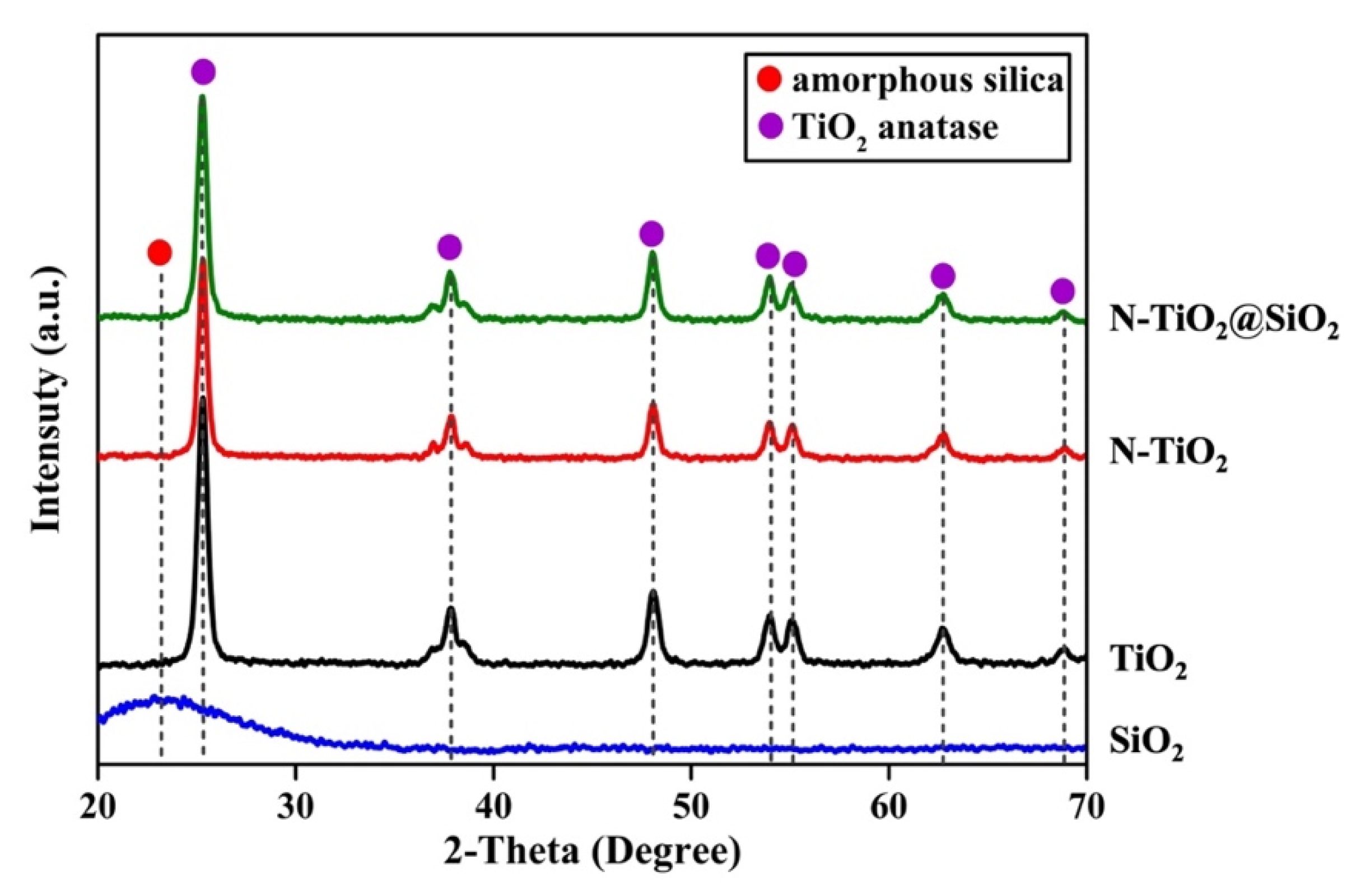
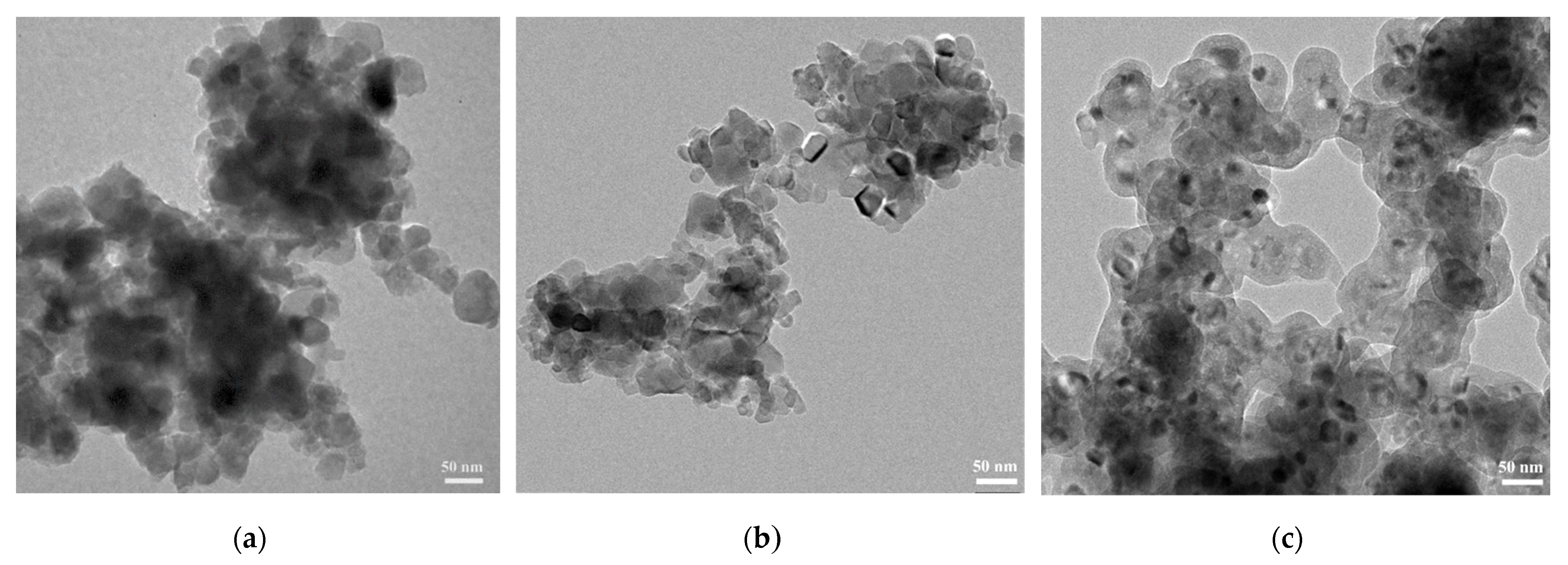

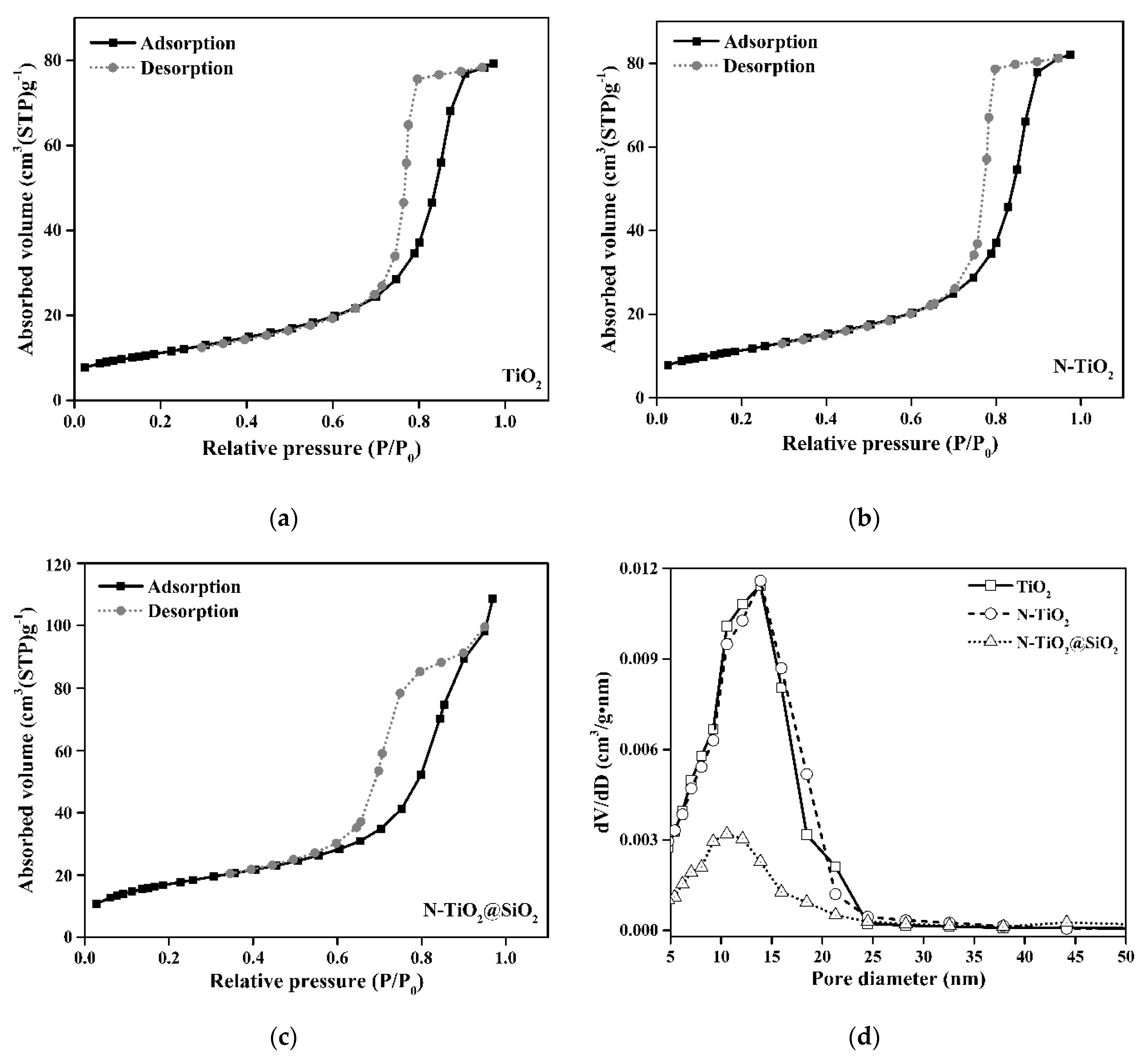




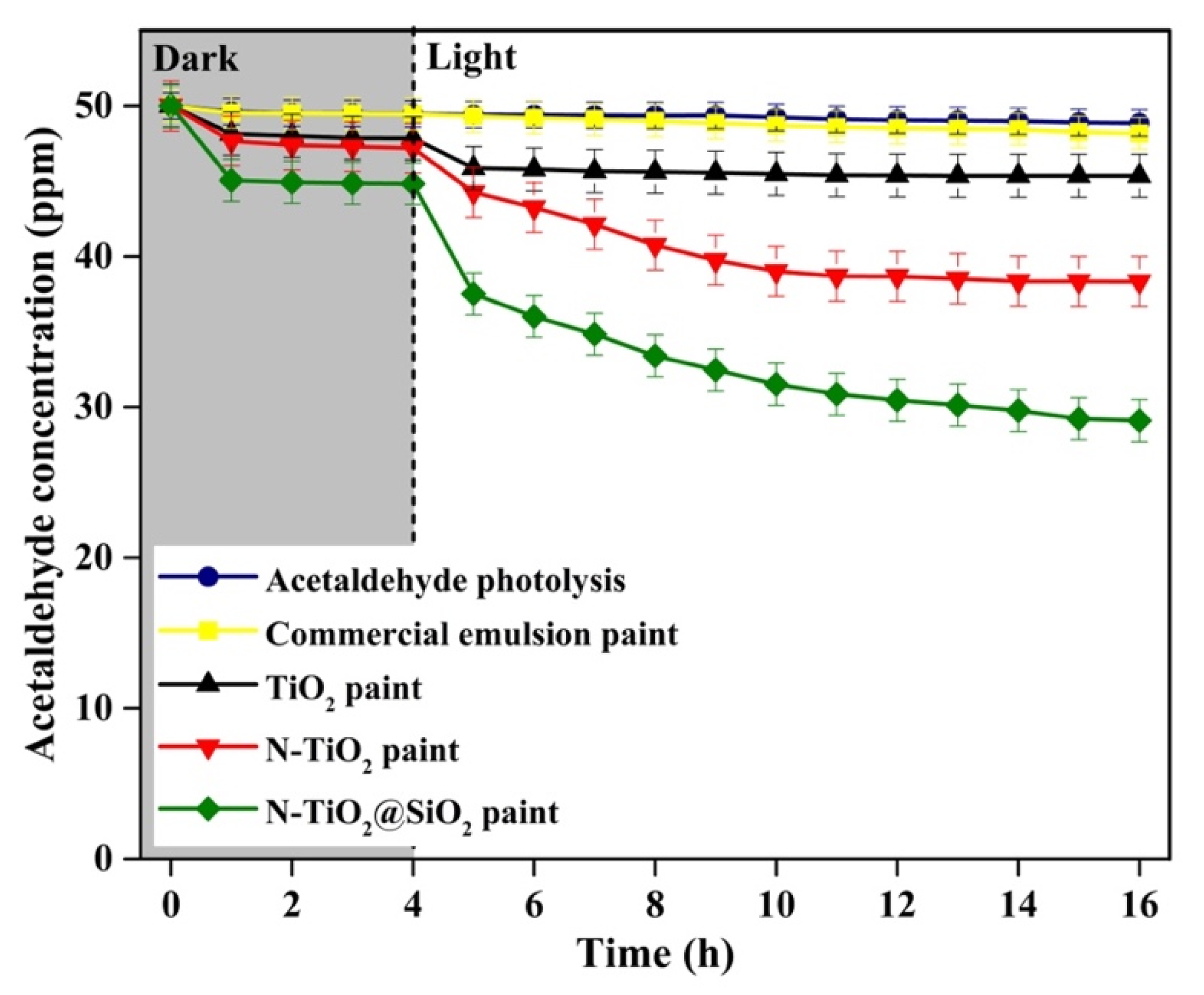
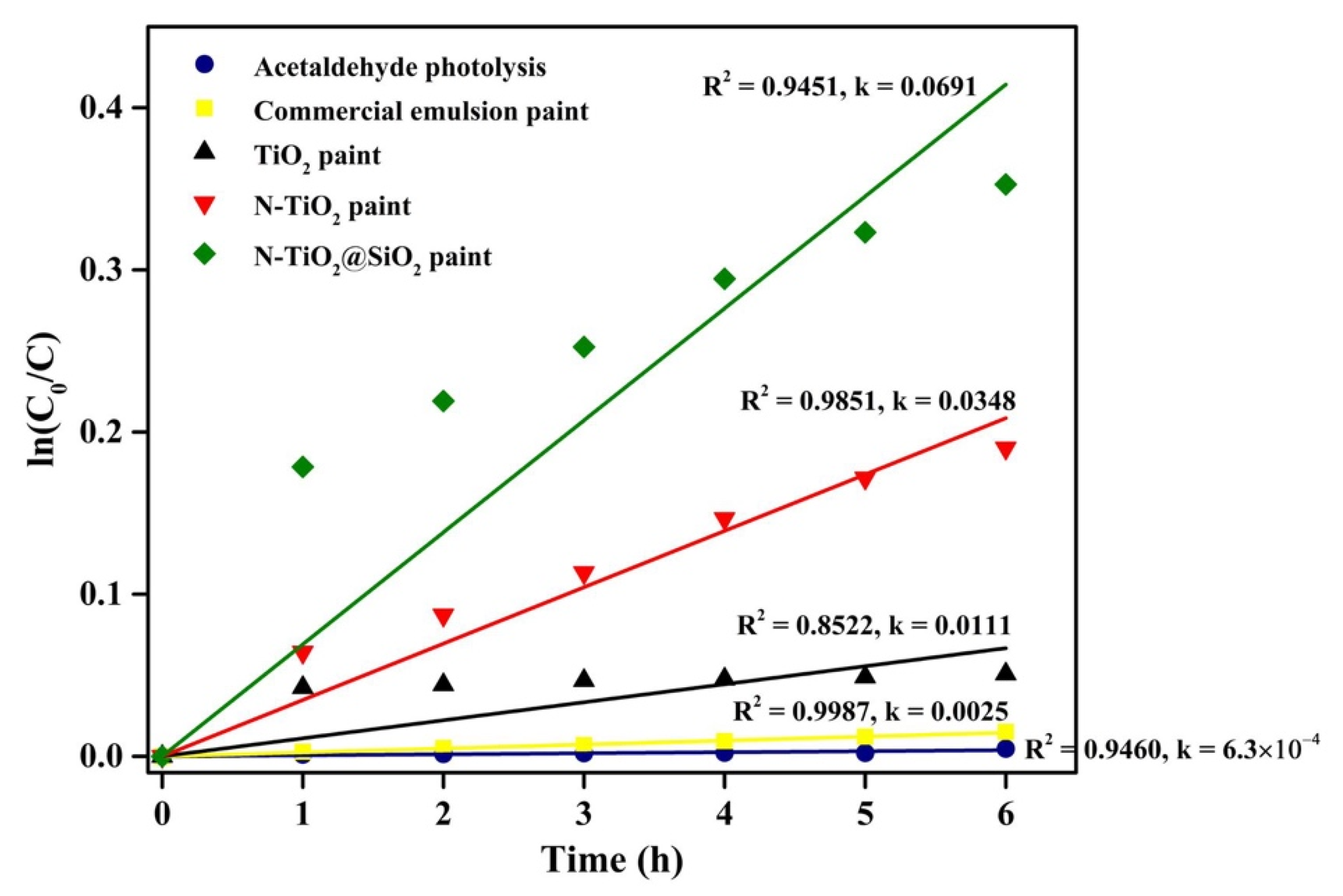
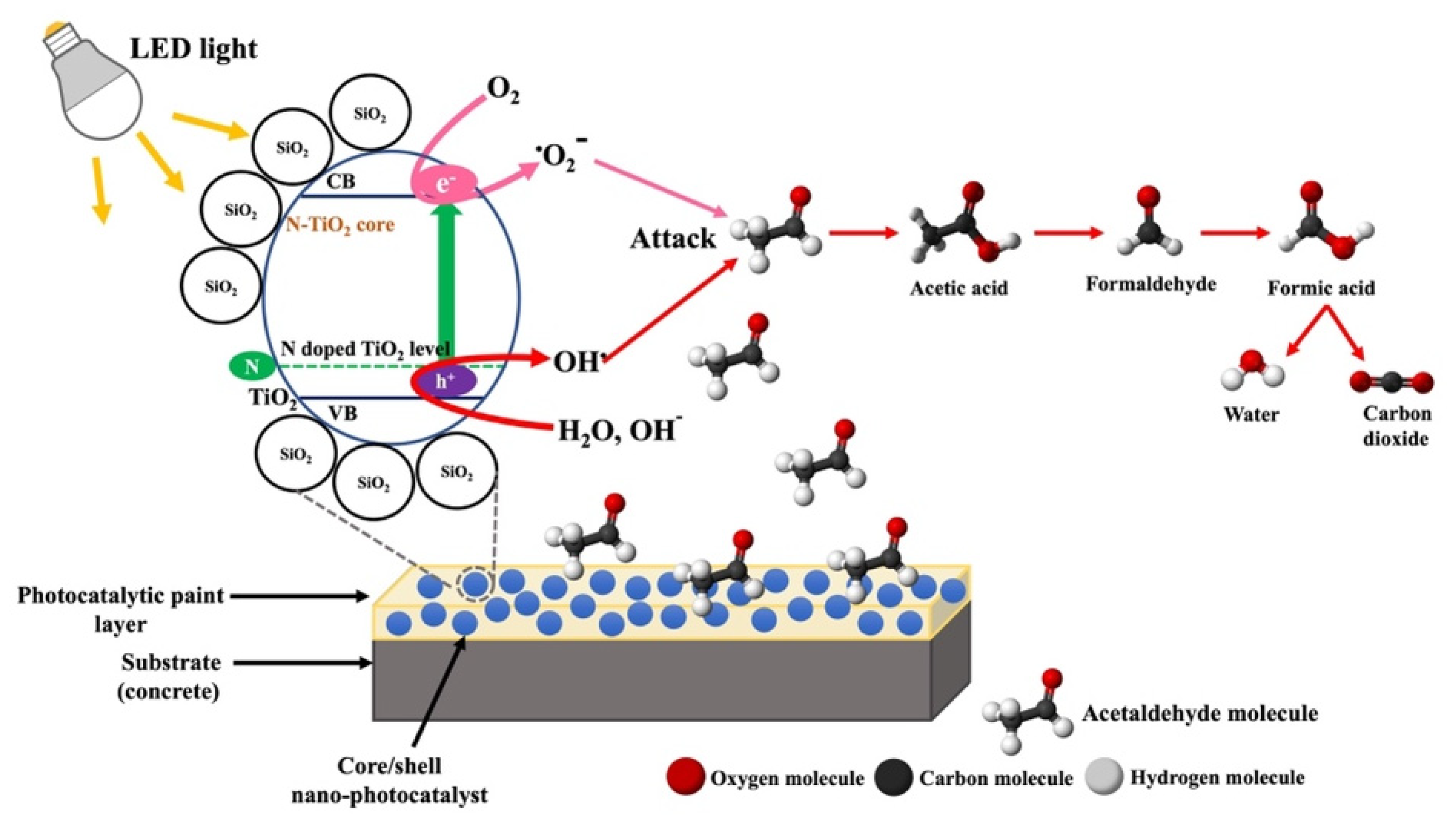
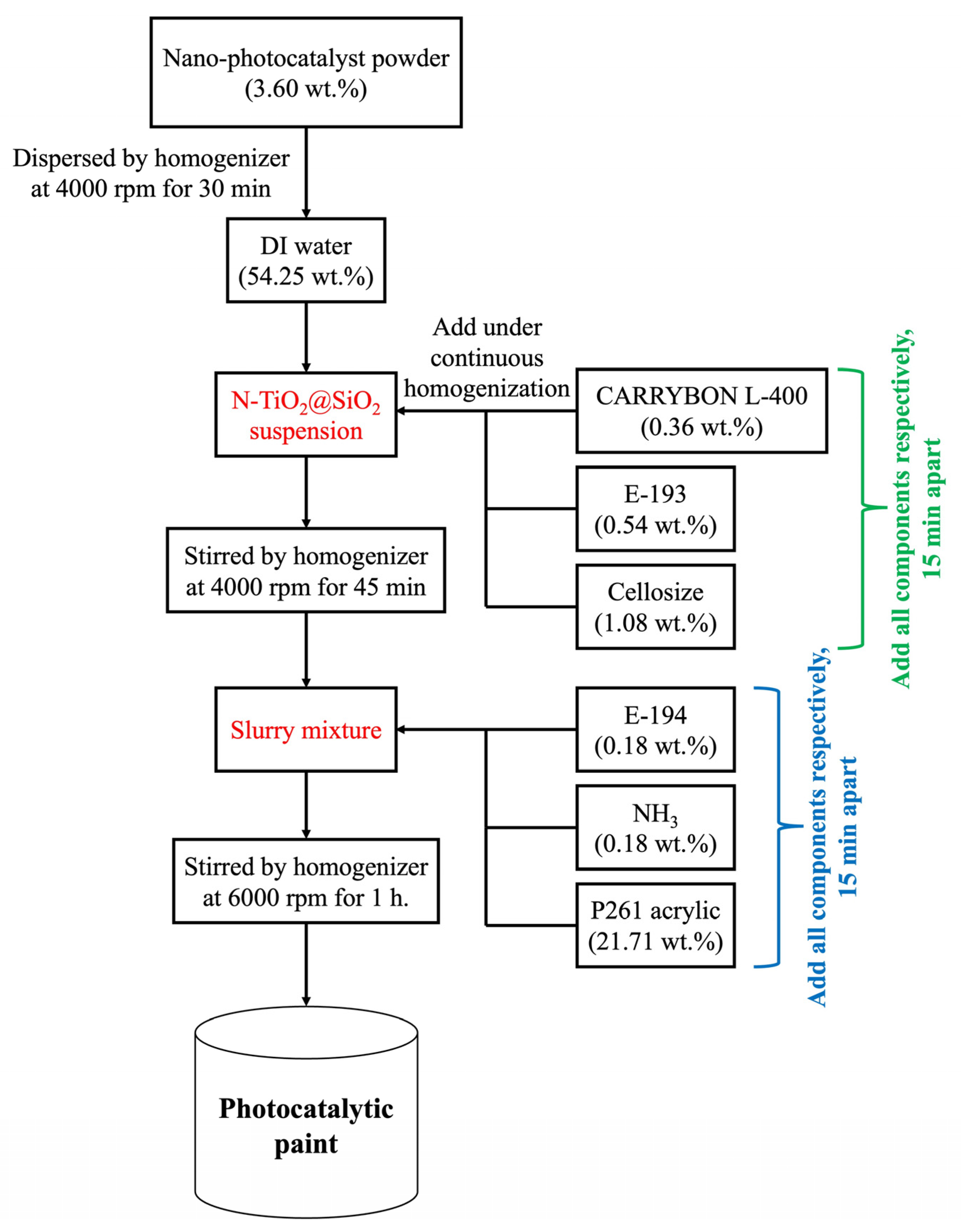
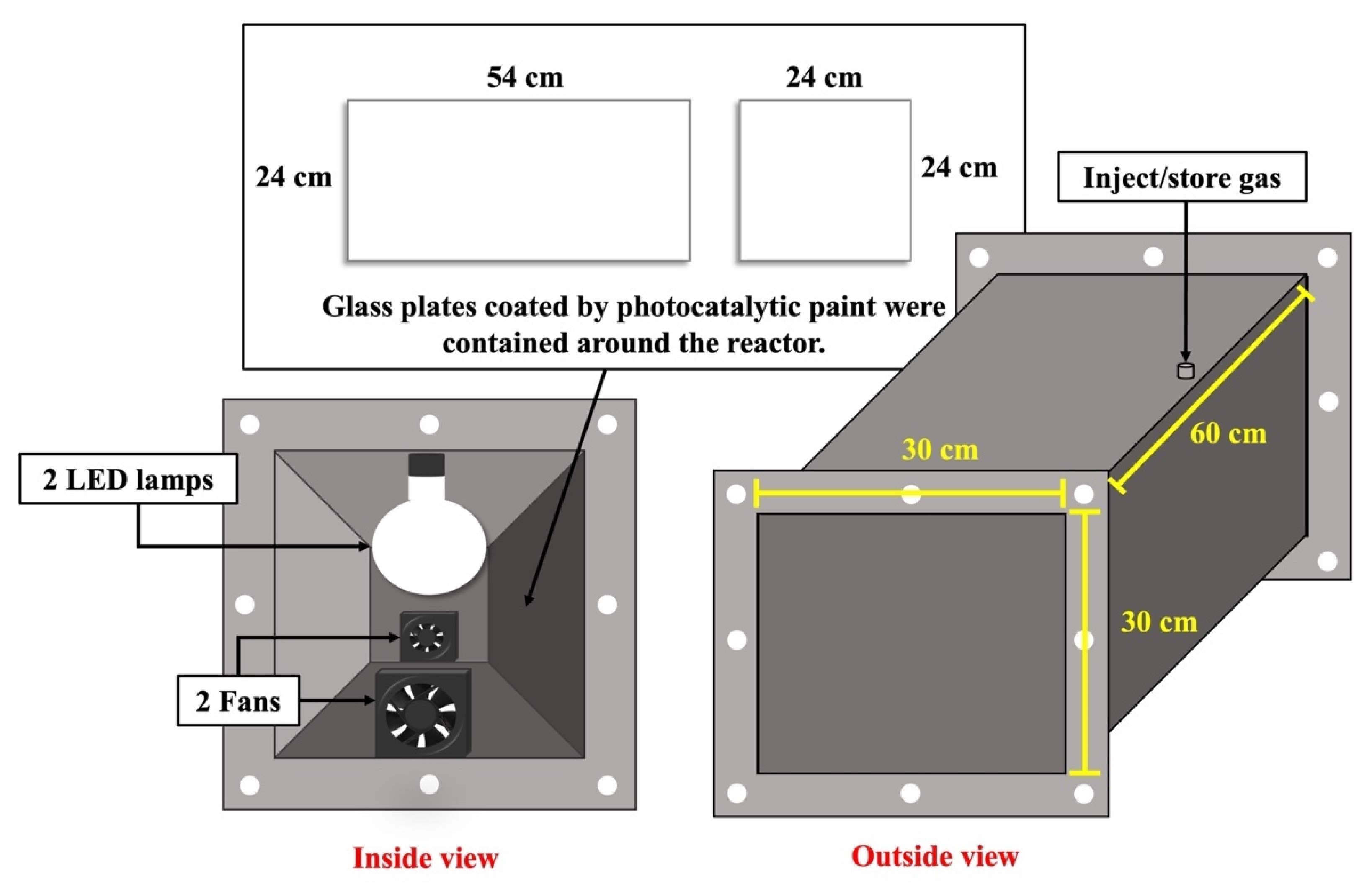
| Ingredient of Photocatalytic Paint | wt.% |
|---|---|
| Nano-photocatalyst powder | 3.60 |
| DI water | 72.53 |
| Dispersing agent (CARRYBON L-400) | 0.36 |
| Defoamer (E-193) | 0.54 |
| Cellosize | 1.08 |
| NH3 | 0.18 |
| Acrylic (P261) | 21.71 |
| Total | 100 |
Disclaimer/Publisher’s Note: The statements, opinions and data contained in all publications are solely those of the individual author(s) and contributor(s) and not of MDPI and/or the editor(s). MDPI and/or the editor(s) disclaim responsibility for any injury to people or property resulting from any ideas, methods, instructions or products referred to in the content. |
© 2023 by the authors. Licensee MDPI, Basel, Switzerland. This article is an open access article distributed under the terms and conditions of the Creative Commons Attribution (CC BY) license (https://creativecommons.org/licenses/by/4.0/).
Share and Cite
Samangsri, S.; Areerob, T.; Chiarakorn, S. Core/Shell Nitrogen-Doped TiO2@SiO2 Nano-Catalyst as an Additive in Photocatalytic Paint for Gaseous Acetaldehyde Decomposition. Catalysts 2023, 13, 351. https://doi.org/10.3390/catal13020351
Samangsri S, Areerob T, Chiarakorn S. Core/Shell Nitrogen-Doped TiO2@SiO2 Nano-Catalyst as an Additive in Photocatalytic Paint for Gaseous Acetaldehyde Decomposition. Catalysts. 2023; 13(2):351. https://doi.org/10.3390/catal13020351
Chicago/Turabian StyleSamangsri, Suwapee, Thanita Areerob, and Siriluk Chiarakorn. 2023. "Core/Shell Nitrogen-Doped TiO2@SiO2 Nano-Catalyst as an Additive in Photocatalytic Paint for Gaseous Acetaldehyde Decomposition" Catalysts 13, no. 2: 351. https://doi.org/10.3390/catal13020351
APA StyleSamangsri, S., Areerob, T., & Chiarakorn, S. (2023). Core/Shell Nitrogen-Doped TiO2@SiO2 Nano-Catalyst as an Additive in Photocatalytic Paint for Gaseous Acetaldehyde Decomposition. Catalysts, 13(2), 351. https://doi.org/10.3390/catal13020351







